- ASIC
- 电池管理 IC
- 时钟和时序解决方案
- ESD 和浪涌保护器件
- Automotive Ethernet
- 评估板
- 高可靠性
- 隔离
- 存储器
- 微控制器
- 功率产品
- 射频
- 安全智能卡解决方案
- 传感器技术
- 小信号晶体管和二极管
- 收发器
- 通用串行总线(USB)
- 无线连接
- 英飞凌大中华区生态圈
- 搜索工具
- 技术
- 封装
- 购买渠道
- 概览
- Automotive Ethernet Bridges
- Automotive Ethernet PHY for in-vehicle networking
- Automotive Ethernet Switches for in-vehicle networking
- 概览
- 嵌入式闪存eFlash IP 解决方案
- RAM和Flash多芯片封装MCP解决方案
- F-RAM铁电存储器
- NOR 闪存
- nvsRAM非易失性存储器
- PSRAM伪静态随机存储器
- 抗辐射和高可靠性的存储器
- RRAM阻变存储器
- SRAM静态随机存储器
- 晶圆和裸片存储器解决方案
- 概览
- AC-DC电源转换
- 电动汽车动力系统
- D 类音频放大器 IC
- 非接触式电源和检测 IC
- DC-DC 转换器
- 二极管&晶闸管 (Si/SiC)
- 氮化镓(GaN)
- GaN EiceDRIVER™高速栅极驱动器
- IGBT 产品及驱动器件
- 智能功率模块(IPM)
- LED 驱动芯片
- 电机控制 IC 和驱动
- 高效能功率MOSFET 和 MOS管
- Power modules
- 电源模块
- 保护和监控IC
- Silicon carbide (SiC)
- 智能电源开关
- 固态继电器
- 无线充电 IC
- 概览
- Calypso® 产品
- CIPURSE™ 产品
- 非接触式存储
- 了解 OPTIGA™ 嵌入式加密解决方案
- SECORA™ 安全解决方案
- 安全控制器
- 智能卡模块
- 政府身份证的智能解决方案
- 概览
- REAL3™ 3D ToF 图像传感器
- MOTIX™ MCU (SoC) 基于 Arm® Cortex®-M0,集成半桥驱动器
- 气体传感器
- Inductive position sensors
- 微机电系统麦克风
- 压力传感器
- 雷达传感器
- 磁性位置传感器
- 磁性速度传感器
- 概览
- USB 2.0 外设控制器
- USB 3.2 外设控制器
- USB 集线器控制器
- USB PD 高压微控制器
- USB-C AC-DC 和 DC-DC 充电解决方案
- USB-C 充电端口控制器
- USB-C 供电控制器
- 概览
- AIROC™ 车载无线
- AIROC™ 蓝牙Bluetooth® 和多协议解决方案
- AIROC™ 互联微控制器
- AIROC™ Wi-Fi + Bluetooth® 组合
- 概览
- FM0+ 32 位 Arm® Cortex-M0®+ 微控制器 (MCU) 系列
-
FM3 32 位 Arm® Cortex-M3® 微控制器 (MCU) 系列
- 概览
- FM3 CY9AFx1xK 系列 Arm® Cortex-M3® 微控制器 (MCU)
- FM3 CY9AFx1xL/M/N 系列 Arm® Cortex-M3® 微控制器 (MCU)
- FM3 CY9AFx2xK/L 系列 Arm® Cortex-M3® 微控制器 (MCU)
- FM3 CY9AFx3xK/L 系列超低漏电流 Arm® Cortex-M3® 微控制器 (MCU)
- FM3 CY9AFx4xL/M/N 系列低功耗 Arm® Cortex-M3® 微控制器 (MCU)
- FM3 CY9AFx5xM/N/R 系列低功耗 Arm® Cortex-M3® 微控制器 (MCU)
- FM3 CY9AFxAxL/M/N 系列超低漏电流 Arm® Cortex-M3® 微控制器 (MCU)
- FM3 CY9BFx1xN/R 高性能系列 Arm® Cortex-M3® 微控制器 (MCU)
- FM3 CY9BFx1xS/T 高性能系列 Arm® Cortex-M3® 微控制器 (MCU)
- FM3 CY9BFx2xJ 系列 Arm® Cortex-M3®微控制器 (MCU)
- FM3 CY9BFx2xK/L/M 系列 Arm® Cortex-M3® 微控制器 (MCU)
- FM3 CY9BFx2xS/T 系列 Arm® Cortex-M3® 微控制器 (MCU)
- FM4 32 位 Arm® Cortex-M4® 微控制器 (MCU) 系列
- 概览
-
TriCore™ AURIX™ TC2x安全模块
- 概览
- AURIX™系列 – TC21xL
- AURIX™ 系列 – TC21xSC (无线充电)
- AURIX™ 系列 – TC22xL
- AURIX™系列 – TC23xL
- AURIX™ 系列 – TC23xLA (ADAS)
- AURIX™ 系列 – TC23xLX
- AURIX™ 系列 – TC264DA (ADAS)
- AURIX™系列 – TC26xD
- AURIX™ 系列 – TC27xT
- AURIX™ 系列 – TC297TA (ADAS)
- AURIX™ 系列 – TC29xT
- AURIX™ 系列 – TC29xTT (ADAS)
- AURIX™系列 – TC29xTX
- AURIX™ TC2x仿真器件
- 32 位TriCore™ AURIX™ – TC3x
- 32 位TriCore™ AURIX™ - TC4x
- 概览
- PSOC™ 4 Arm® Cortex®-M0/M0+
- PSOC™ 4 HV Arm® Cortex®-M0+
- PSOC™ 5 LP Arm® Cortex®-M3
- PSOC™ 6 Arm® Cortex-M4®/M0+
- PSOC™ Multitouch Arm® Cortex®-M0
- 32 位 PSOC ™ Control Arm® Cortex ® -M33 MCU
- PSOC™ Fingerprint Arm® Cortex®-M0+
- PSOC™ Automotive 4: Arm® Cortex®-M0/M0+
- PSOC™ Edge Arm® Cortex® M55/M33
- 概览
- 32 位 TRAVEO™ T2G Arm® Cortex®用于车身电子应用
- 用于仪表盘的 32 位 TRAVEO™ T2G Arm® Cortex®
- 概览
- 32 位XMC1000工业微控制器 Arm® Cortex-M0®
- 32 位XMC4000工业微控制器 Arm® Cortex-M4®
- XMC5000 Industrial Microcontroller Arm® Cortex®-M4F
- 32 位XMC7000工业微控制器 Arm® Cortex-M7®
- 概览
- 桥式整流器和交流开关
- CoolSiC™ 肖特基二极管
- 二极管裸片
- 硅二极管
- 晶闸管/二极管模块
- 晶闸管软启动器模块
- 晶闸管/二极管盘
- 概览
- 32-bit PSOC™ Control Arm® Cortex®-M33 MCU
- iMOTION™集成电机控制解决方案
- Embedded Power ICs (System-on-Chip) -146
- MOTIX™电机控制IC用于BLDC电机
- MOTIX™ 电机控制IC,用于有刷直流电机
- MOTIX™ 多半桥IC用于伺服和步进电机
- 概览
- 汽车级MOSFET
- 双 MOSFET
- MOSFET(Si 和 SiC)模块
- N 沟道耗尽型 MOSFET
- N沟道MOS管
- 碳化硅 CoolSiC™ MOSFET
- 250V至600V G14小信号MOS
- 概览
- OPTIGA™ Authenticate
- OPTIGA™ Authenticate NFC 解决方案
- OPTIGA™ Connect – 交钥匙式 eSIM 安全解决方案
- OPTIGA™ Trust
- OPTIGA™ 可信平台模块 (TPM)
- 概览
- EZ-PD™ ACG1F 单端口 USB-C 控制器
- EZ-PD™ CCG2 USB Type-C 端口控制器
- EZ-PD™ CCG3PA Automotive USB-C 和 Power Delivery 控制器
- EZ-PD™ CCG4 双端口 USB-C 和 PD
- EZ-PD™ CCG5 双端口和 CCG5C 单端口 USB-C PD 控制器
- EZ-PD™ CCG6 单端口 USB-C & PD 控制器
- EZ-PD ™ CCG6_CFP 和 EZ-PD ™ CCG8_CFP 双单端口 USB-C PD
- EZ-PD™ CCG6DF 双端口和 CCG6SF 单端口 USB-C PD 控制器
- EZ-PD™ CCG7D 汽车双口 USB-C PD + DC-DC 控制器
- EZ-PD™ CCG7S 汽车单口 USB-C PD 解决方案,配备DC-DC控制器
- EZ-PD™ CCG7SAF 车规级单端口 USB-C PD + DC-DC 控制器 + FETs
- EZ-PD™ CCG8 双/单口 USB-C PD
- EZ-PD™ CMG1 USB-C EMCA 控制器
- 支持 EPR 的 EZ-PD™ CMG2 USB-C EMCA 控制器
- 最新动态
- 航空航天
- 智能汽车解决方案
- 消费类电子产品
- 健康和 生活方式
- 家用电器
- 工业
- 信息和通信技术
- 可再生能源
- 机器人
- 安全解决方案
- 智能家居和楼宇
- 解决方案
- 概览
- 适配器和充电器
- 适用于智能电视的完整系统解决方案
- 移动设备和智能手机解决方案
- 多旋翼飞机和无人机
- 电动工具
- 家庭娱乐应用的半导体解决方案
- 智能会议系统
- 概览
- 适配器和充电器
- 资产跟踪
- 电池化成和测试
- Electric forklifts
- Battery energy storage (BESS)
- 电动汽车充电
- 高压固态配电系统
- 工业自动化
- 工业电机驱动和控制
- 工业 4.0 的工业机器人系统解决方案
- LED 照明系统设计
- 轻型电动车解决方案
- 电动工具
- 电力传输和配电
- 轨交
- 不间断电源 (UPS)
- 概览
- 汽车辅助系统
- 车载网关
- 汽车配电系统
- 车身控制模块 (BCM)
- 舒适便捷电子产品
- 区域 DC-DC 转换器 48 V-12 V
- 区域控制器
- 概览
- 汽车车载主机
- 汽车 USB-C 电源和数据解决方案
- 汽车仪表盘
- 汽车远程信息处理控制单元 (TCU)
- 中央信息显示屏(CID)
- 高性能驾驶舱控制器
- 舱内无线充电
- 智能仪表盘(电动两轮车和三轮车)
- 最新动态
- 概览
- AIROC™ 软件&工具
- AURIX™应用软件
- Drive Core 用于汽车软件开发
- iMOTION™ 工具和软件
- Infineon智能功率开关和栅极驱动器工具套件
- MOTIX 软件&工具
- OPTIGA™工具和软件
- PSOC™ 软件&工具
- TRAVEO™ 软件&工具
- XENSIV™ 工具和软件
- XMC™ 工具和软件
- 概览
- DEEPCRAFT™ 人工智能中心
- DEEPCRAFT™ Audio Enhancement
- DEEPCRAFT™ Model Converter
-
DEEPCRAFT ™准备模型
- 概览
- DEEPCRAFT™ Ready Model for Baby Cry Detection
- DEEPCRAFT™ Ready Model for Cough Detection
- DEEPCRAFT™ Ready Model for Direction of Arrival (Sound)
- DEEPCRAFT™ Ready Model for Factory Alarm Detection
- DEEPCRAFT™ Ready Model for Fall Detection
- DEEPCRAFT™ Ready Model for Gesture Classification
- DEEPCRAFT™ Ready Model for Siren Detection
- DEEPCRAFT™ Ready Model for Snore Detection
- DEEPCRAFT ™工作室
- DEEPCRAFT™ Voice Assistant
- 概览
- EZ-PD™ CCGx Dock 软件开发工具包
- FMx Softune IDE
- ModusToolbox™ 软件
- PSOC™ Creator软件
- 雷达开发套件
- 锈
- USB 集线器控制器
- 无线连接蓝牙网状网络辅助应用程序
- XMC™ DAVE™ Software
- 最新动态
- 支持
- 培训
- 英飞凌开发者社区
- 最新消息
商业财经新闻
17/11/2025
季度报告
12/11/2025
商业财经新闻
12/11/2025
商业财经新闻
05/11/2025
- 公司名称
- 我们的故事
- 活动资讯
- 新闻中心
- 投资者
- 职业生涯
- 质量
- 最新消息
商业财经新闻
17/11/2025
季度报告
12/11/2025
商业财经新闻
12/11/2025
商业财经新闻
05/11/2025

Advancing public transportation: Beyond mass transit to door-to-door solutions
How can the integration of various modes of transportation such as trains, buses and robot taxis contribute to achieving a holistic and efficient urban mobility system that caters to the diverse needs of commuters?
07/07/2025



The integration of a diverse range of transportation modes, including trains, buses, and autonomous vehicles, is the key to tomorrow’s clean, safe and smart mobility landscape. The focus is no longer just on mass transportation, but on creating transportation options tailored to the individual requirements of commuters while optimizing the efficiency of urban mobility. Each journey should ideally be customized to each traveler's individual needs.
Linking public transportation with shared mobility services paves the way for increased convenience and effectiveness. To achieve this, planners must create a connected transportation system that seamlessly interconnects all modes of travel and mobility.



How would this work in reality?
Imagine a commuter who starts their journey by hopping on a shared electric scooter from their doorstep to get to a nearby bus stop. From there, they seamlessly transition to a high-speed train that takes them across the city, followed by a short ride on an autonomous shuttle that drops them off directly at their workplace. This interconnected network of transportation modes gives us a glimpse into a future where getting around the city is not only efficient but also fun.
Shared mobility options like ride-sharing services and bike-sharing programs have already begun to transform urban traffic. These services complement traditional mass transit systems by filling gaps in accessibility and providing flexible connectivity right up to the last mile.
The role of technology in modernizing public transportation
Technology is already playing a pivotal role in transforming public transportation systems and this is set to become even more pronounced. Semiconductors, for instance, are essential for enabling clean and efficient mobility solutions. Infineon, a leader in semiconductor technology, is at the forefront of this transformation, providing components that power electric vehicles, optimize energy consumption, and enhance safety. These innovations are crucial for achieving the dual goals of reducing emissions and improving the overall efficiency of public transportation systems.
Sustainable momentum
Electric buses are a cornerstone of sustainable urban mobility. Unlike conventional diesel-powered buses, electric buses produce zero emissions, significantly reducing carbon dioxide and nitrogen oxide emissions in urban areas. However, the transition to electric buses requires robust and reliable technologies. Our semiconductor solutions are designed to meet these challenges, enabling efficient energy conversion, reducing weight, and improving overall vehicle performance. These advancements not only contribute to a greener future but also enhance the comfort and reliability of public transportation.
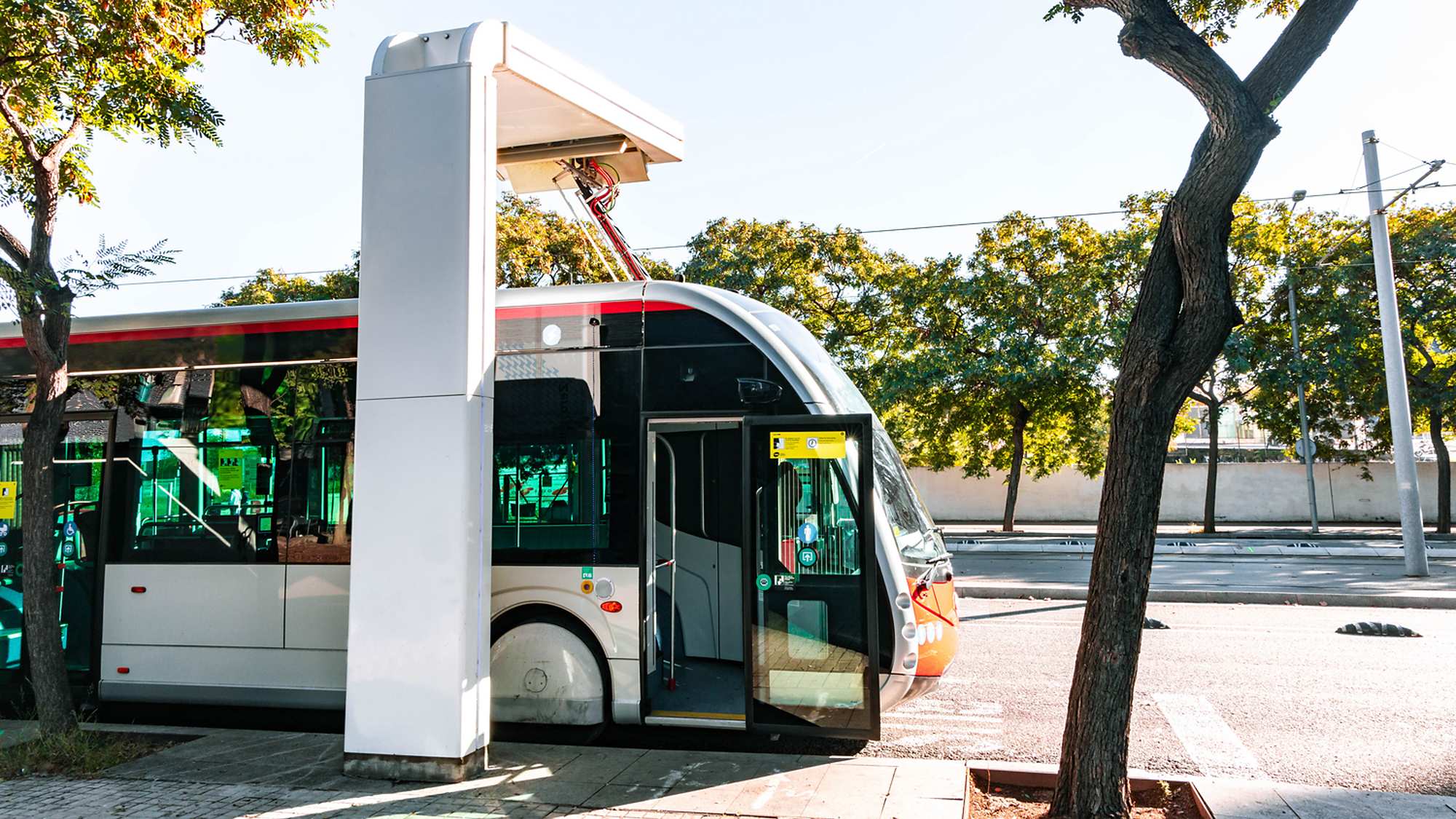
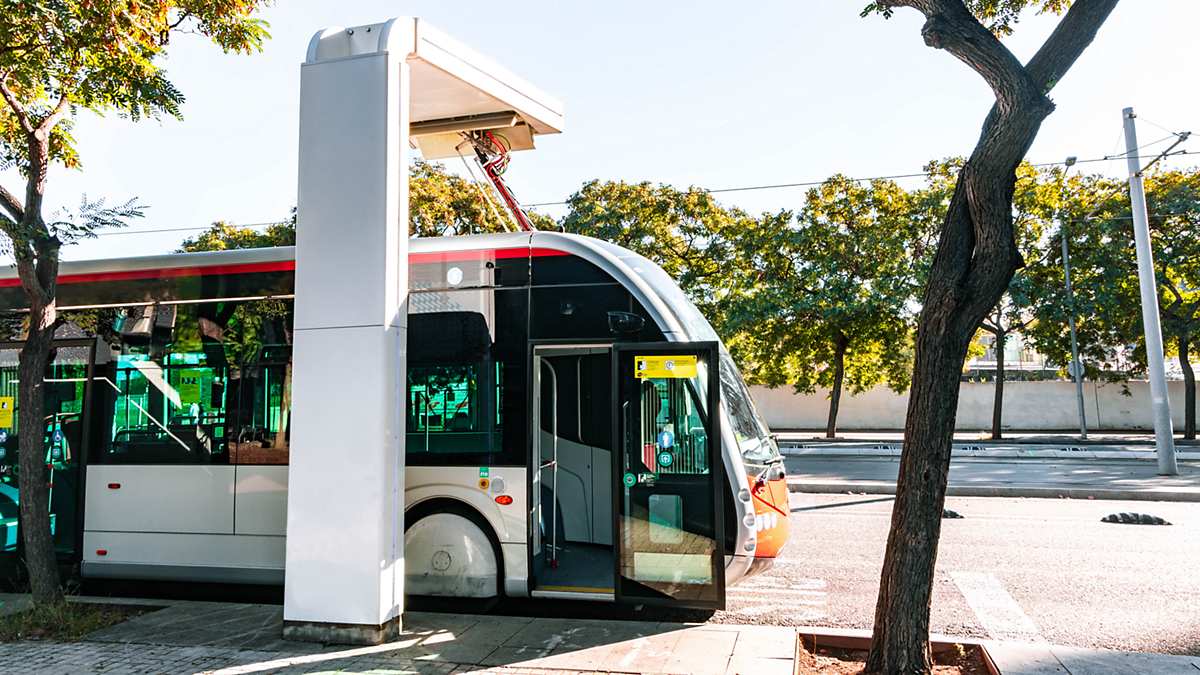
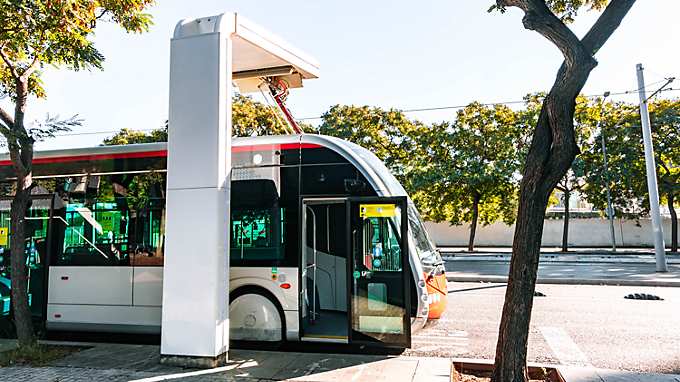
Semiconductors unleash potential of clean and robust buses
Buses cover significant distances every day and clock up far greater total mileage over their service lives than other vehicles. This can typically be more than 1.5 million kilometers compared to only 300,000 kilometers or so for a car. This all has an impact on the power electronics on board the bus: The electronic parts have to be more robust and dependable. Semiconductor solutions empower electric propulsion and help reconvert energy efficiently during braking. Also, they let manufacturers build buses with less weight, better acceleration, and energy-efficient air conditioning, lighting and door openers.
We provide efficient components specifically for fuel-cell electric buses that reduce energy losses and enable designers to meet the relevant regulations, standards and safety requirements.
Increased energy-efficiency and less noise on the rails
In many urban areas, underground and suburban trains and trams are important in reducing road traffic. At the same time, they offer a favorable carbon balance and – when operated electrically – release zero emissions. The figures speak for themselves. For example, a traveler on a one-way train trip from Munich to Paris saves 150 kg of CO2 compared to flying, and arrives in the French capital in just over six hours on the fastest connection.
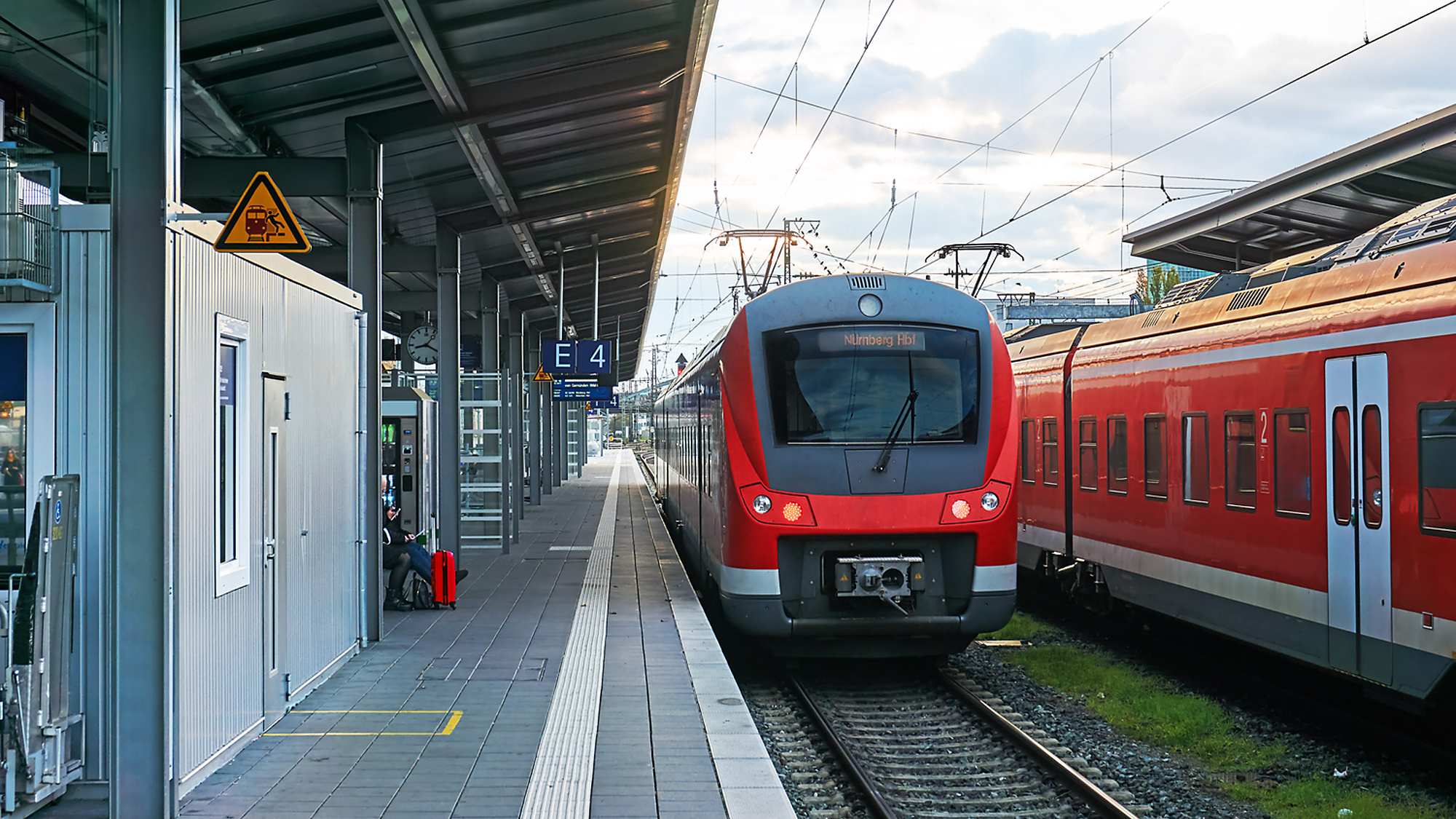
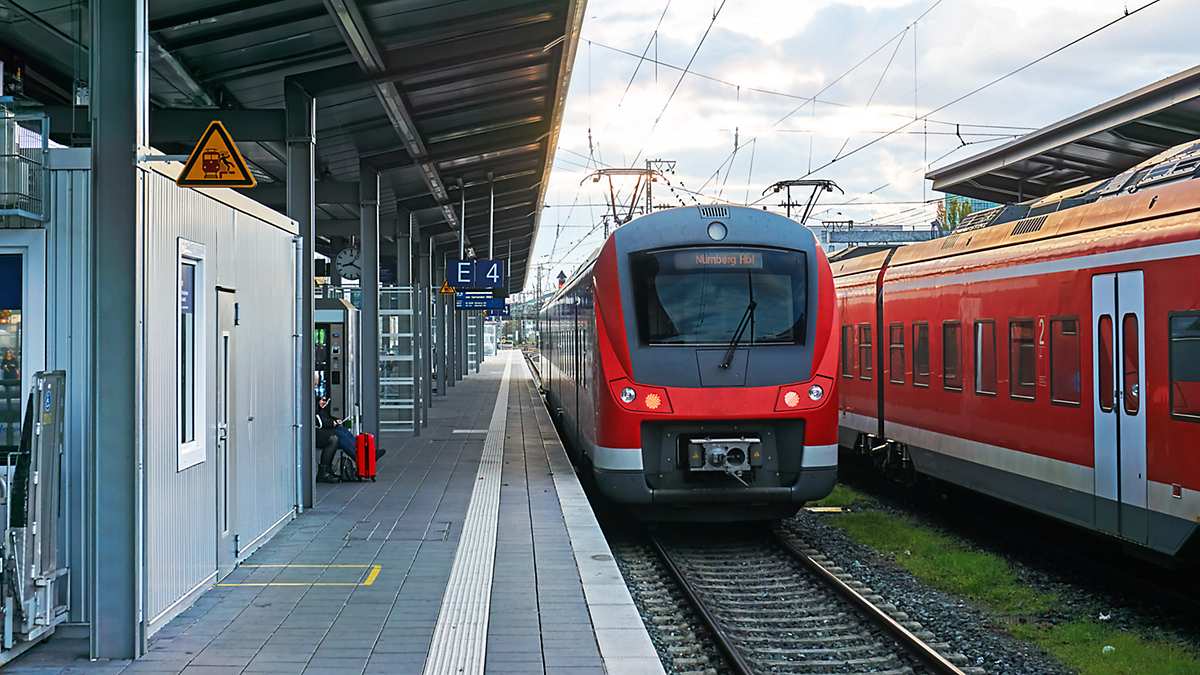
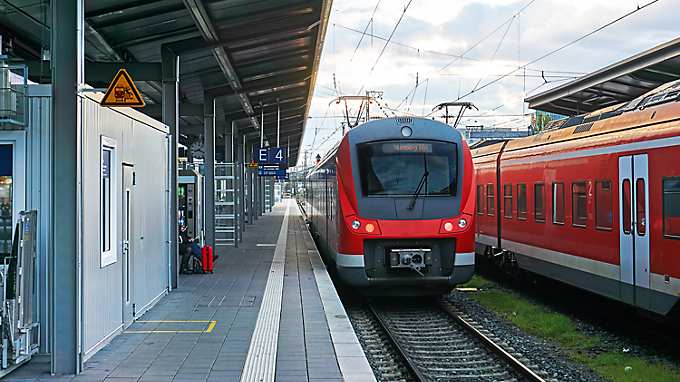
We cover all segments in traction transportation, ranging from trams and subways through regional and high-speed trains to locomotives for freight transport. Building on our deep understanding of the challenges of today and the future, we offer a comprehensive product portfolio of best-in-class solutions as the basis for traction systems with the highest power densities and excellent efficiency. Our components stand out because of their long service lives. They are engineered to provide the reliability that traction applications need so they can keep running year after year in harsh environmental conditions.
Take the CoolSiC™ 3.3 kV XHP™ module with XT technology, for instance. This essential building block for traction converters in trains enables our customers to build converters with huge advantages, including:
- High efficiency
- Motor-friendly designs
- Long service life
- Cost competitiveness
The result? Trains that are:
- Less noisy
- More robust and reliable
- More comfortable for passengers
Joint field test proves the benefits of SiC technology in public transportation
We are a key player in the development of silicon carbide (SiC) technology and its qualification for use in rolling stock. For example, our XHP™ 2 power modules based on SiC technology have proven their worth in a joint field test in Munich, creating benefits for manufacturers, rail operators, and residents: A Siemens Avenio tram used by the local German transport company MVG for passenger services was equipped with XHP™ 2 power modules and tested in the field for a year, covering around 65,000 km. Siemens Mobility concluded that the use of power semiconductors based on SiC enabled a ten percent reduction in the energy consumed by trams.
At the same time, it was also possible to significantly reduce noise during operation. The tests were carried out under the European development and research project PINTA and are part of the European research initiative Shift2Rail, the objective of which is to create a sustainable European rail system.
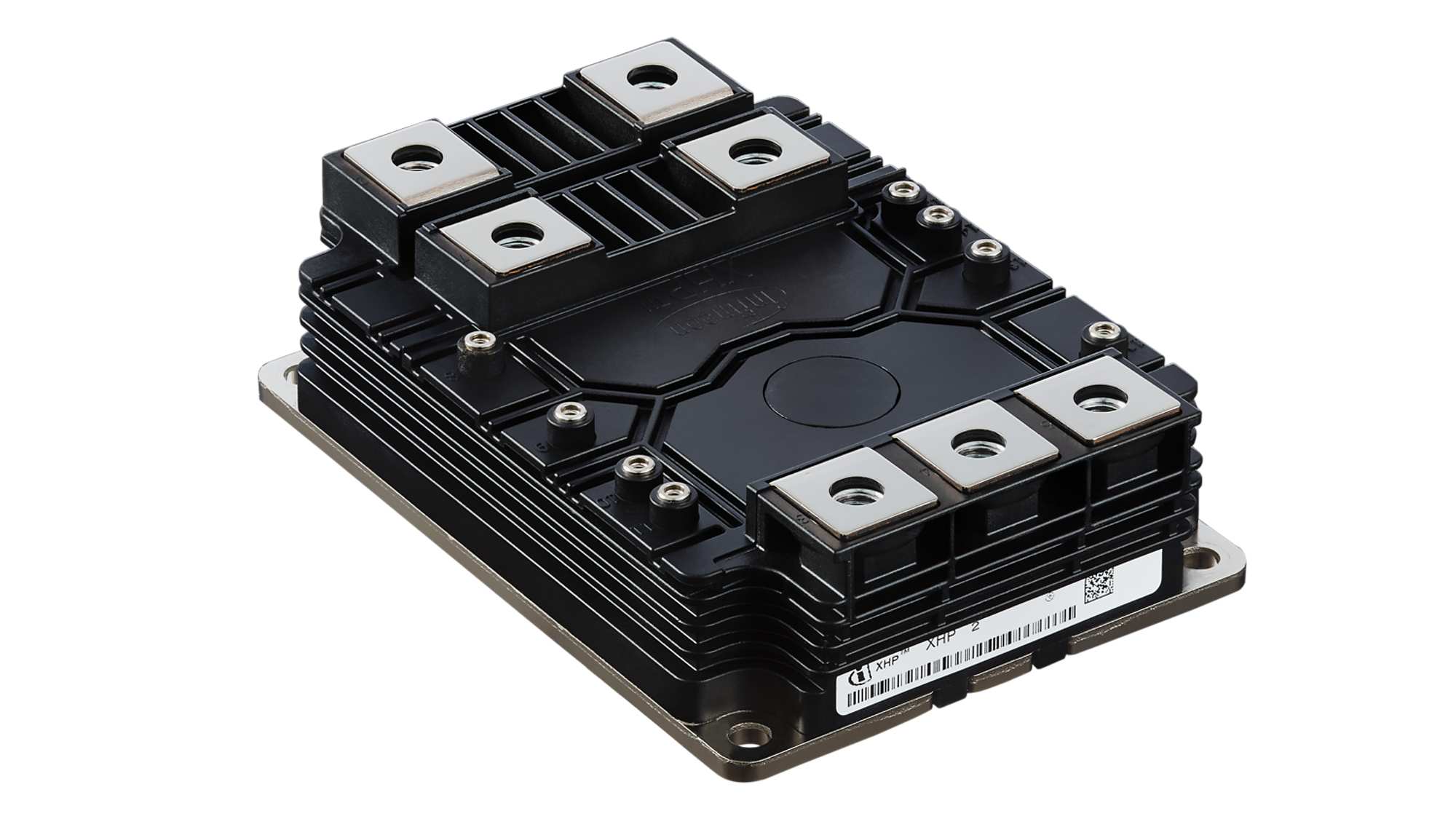
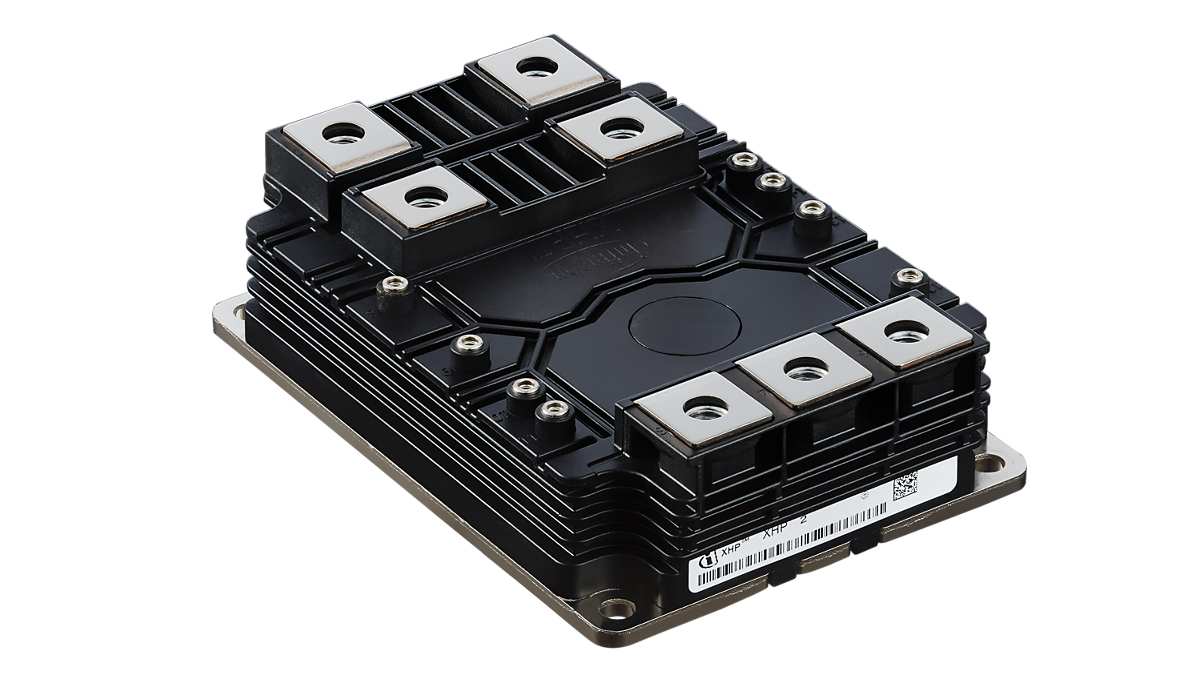
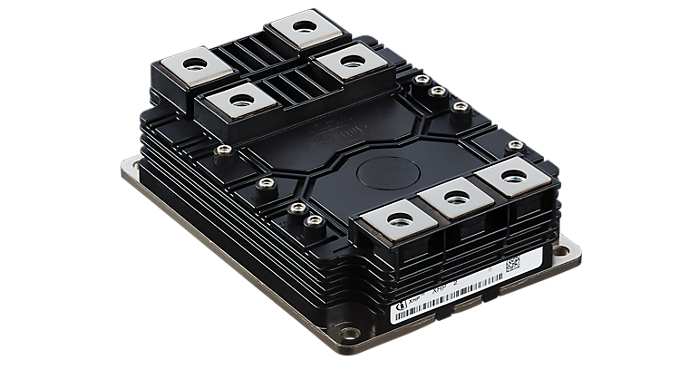
The key features of the XHP™ 2 CoolSiCTM MOSFET — lower losses, higher switching frequency, and higher power density — can be directly translated to multiple system benefits. These include energy efficiency, system size and weight savings, and tangible noise reductions.